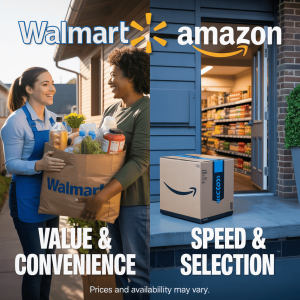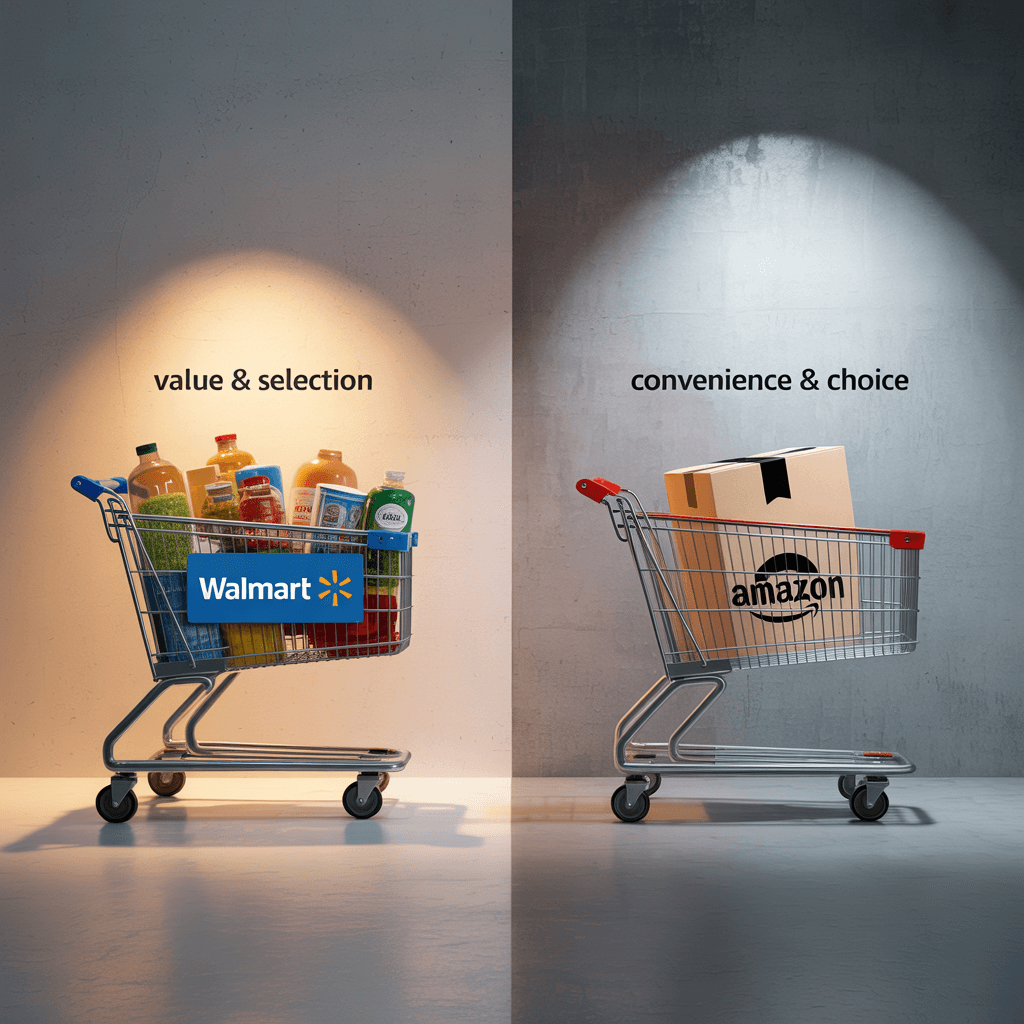Is the battle of Amazon vs Walmart quietly deciding your ecommerce future? For millions of sellers and shoppers alike, the debate isn’t just about price tags or product range, it’s about who’s actually winning in the modern ecommerce arena. One dominates with global reach and Prime-powered perks.
The other offers an evolving hybrid model built on affordability and brand trust. If you’re stuck comparing Amazon prices vs. Walmart strategies or deciding where your brand will thrive, it’s time to strip back the hype and dive into the real differences.
This guide isn’t another surface-level breakdown. It’s the 2025 blueprint for ecommerce sellers ready to scale, those comparing Amazon vs Walmart for selling with profit, not guesswork.
Amazon vs Walmart: Who Owns the Digital Shelf?
Amazon’s marketplace has ruled ecommerce for years. With hundreds of millions of active shoppers and a perfected logistics engine in Amazon FBA, it’s hard to ignore the power behind an Amazon store setup and optimization done right.
Walmart, on the other hand, is playing a long game. Backed by in-store dominance and a growing digital edge, Walmart Marketplace is attracting serious third-party sellers and fast.
Reach and Audience: Mass vs. Mainstream
- Amazon’s reach is global, and its audience spans from luxury seekers to bargain hunters.
- Walmart.com appeals to a U.S.-based, price-sensitive audience. Think essentials, groceries, and big-brand loyalty.
But here’s where things get interesting: while Amazon shines in electronics, niche categories, and international sales, Walmart punches hard in grocery, household, and everyday value.
If your product thrives on volume and consistent demand, selling on Walmart might deliver bigger returns with less competition.
Selling on Amazon and Walmart: What Sellers Really Need to Know
Let’s get tactical. Selling on Amazon and Walmart comes with two very different onboarding and operational realities. One offers scale with saturation. The other offers control but with barriers.
Onboarding and Approval
- Amazon welcomes individual sellers and businesses alike. Solo founders can get up and running with minimal friction.
- Selling on Walmart requires business verification. No SSN signups. You’ll need a registered entity, tax ID, and proof of ecommerce performance.
This initial step alone filters out casual sellers and puts Walmart Marketplace in the hands of more established brands.
Fulfillment Models: Amazon FBA vs Walmart WFS
When comparing Amazon vs Walmart for selling, fulfillment is a deal-breaker for many. Amazon FBA has long been the gold standard. Sellers tap into Amazon’s warehouse network, hand off logistics, and gain the powerful Amazon Prime membership badge in the process.
Walmart’s answer? Walmart Fulfillment Services (WFS). It offers similar perks: 2-day shipping tags, warehousing, and returns management but it’s newer and less saturated.
Here’s how they stack up:
| Feature | Amazon FBA | Walmart WFS |
| Prime/Badging | Amazon Prime membership badge | Walmart 2-day shipping tag |
| Logistics Reach | Global | U.S.-centric |
| Competition Level | Very High | Moderate |
| Onboarding Ease | Easy | Selective Approval |
Selling on Walmart vs Amazon: Which Platform Fits Your Product?
More than just setting up shop, it’s about knowing your niche. The ecommerce battlefield is different depending on what you sell and how much margin you can give up.
Comparing Amazon Prices vs. Walmart
Shoppers are savvy in 2025. They’re already comparing Amazon prices vs. Walmart before hitting “Add to Cart.” Sellers need to align with those behaviors:
- Tech products often sell better on Amazon due to consumer trust in Amazon’s warranties and fast shipping.
- Household, grocery, and personal care items fly on Walmart due to pricing and Walmart+ perks.
If your products lean into affordability and everyday use, Walmart might offer higher conversion at a lower ad spend.
Tools and Data: Who Supports Sellers Better?
In 2025, guessing is dead. Sellers are relying on data to survive, especially in highly competitive categories.
Amazon offers powerful analytics inside Seller Central. Combined with external tools like Helium 10, sellers can find exact-match keywords, monitor competitors, and track performance in real-time.
Curious about how to do Amazon product research with Helium 10? You can dig into trend patterns, product viability scores, and keyword gaps, crucial data Walmart currently lacks at scale.
Walmart’s seller tools are improving, but they’re still catching up. Sellers using Walmart.com often rely on Amazon data to make Walmart decisions, a clear sign of Amazon’s lead in ecommerce intelligence.
Advertising Ecosystems: Visibility Comes at a Cost
Amazon’s advertising options are vast, Sponsored Products, Brands, Display, and now even Streaming TV Ads. But those clicks come at a premium. CPC costs are climbing, especially in saturated markets.
Walmart is more affordable on the ad front, offering Sponsored Products and Search Brand Amplifier. Sellers can test smaller budgets without bleeding ROI. If your product needs visibility on a budget, Walmart ads offer an efficient alternative.

Brand Control and Storefront Customization
How much control do sellers really have over their brand presence?
Amazon’s marketplace is powerful, but it’s not your playground. Product pages follow a rigid format. Even if you own the brand, hijackers and unauthorized resellers can appear, causing issues with Buy Box eligibility and customer confusion.
Amazon store setup and optimization can give you some control, through A+ Content, Brand Registry, and storefronts but you’re still under Amazon’s rulebook.
Walmart, meanwhile, is catching up in branded customization. Sellers can now create enhanced content with rich media, brand stories, and even video. And because the platform isn’t as crowded, it’s easier to stand out.
If building a recognizable brand experience is key to your strategy, both platforms offer options but Walmart may provide fewer hoops and more flexibility in a less saturated environment.
Trust, Loyalty, and Subscription Models
Amazon Prime membership is the crown jewel of customer retention. Over 200 million global members enjoy free shipping, exclusive deals, Prime Video, and more. For sellers, this means products with Prime eligibility see higher conversion rates, shoppers know what they’re getting, and they get it fast.
Walmart’s response? Walmart+, a subscription offering free delivery and member-only prices. It’s growing, but adoption still lags behind Prime. The trust level is high for in-store purchases, but online loyalty hasn’t caught up yet.
For ecommerce brands looking to capitalize on subscription habits, Amazon still dominates. Products with Prime shipping simply move faster, especially in impulse or gift-driven categories.
Backend Support and Seller Ecosystem
Customer service, returns, and account health, all are critical components of a sustainable ecommerce business. Amazon has a love-hate relationship with its sellers. Support exists, but so do suspensions, auto-bans, and bot-driven enforcement that often leave sellers scrambling.
Selling on Amazon comes with power, but also volatility.
Walmart’s backend system is more seller-friendly in some aspects. Fewer bots, more human support, and a longer rope when mistakes happen. But its dashboard and tools still lack the polish and depth of Amazon’s.
For new sellers, Walmart might feel more forgiving. For advanced sellers with complex operations, Amazon’s tools, especially when paired with automation platforms, still win.
Pricing and Profit Margins: The Real Bottom Line
Amazon’s marketplace fees include referral fees, FBA fees, storage fees, and advertising costs that add up quickly. For many sellers, Amazon’s fees eat 30–45% of the sale price. High-volume sellers make it up in speed and scale, but margins can suffer.
Walmart charges fewer fees and doesn’t offer a fulfillment program as costly as FBA, yet. Sellers often see slightly better margins on Walmart, especially when operating at lower ad spend and less intense price competition.
However, the tradeoff? Lower traffic.
To make Walmart work, sellers need to build volume through external traffic or become top-of-category early. Amazon gives you volume, but at the cost of tighter profits.
Amazon vs. Shopify: How Does Walmart Fit Into the Mix?
Ecommerce in 2025 isn’t about choosing just one platform. It’s about building a multichannel presence that can flex, scale, and pivot with consumer trends.
You’ve likely seen guides like Amazon vs. Shopify – Which Storefront Strategy Actually Makes You Money? The truth is: all three have a place.
- Shopify gives you full control and branding—but zero baked-in traffic.
- Amazon brings the buyers but owns the rules (and your customer list).
- Walmart sits in between: better margins than Amazon, better visibility than Shopify.
If you’re already on Shopify or Amazon, expanding into Walmart isn’t just smart, it’s necessary. Sellers who embrace omnichannel in 2025 will outperform those stuck on a single platform.
Amazon Product Research: A Winning Edge on All Platforms
Whether you’re selling on Walmart vs Amazon or trying to scale both, research is non-negotiable.
This is where Helium 10 shines.
Wondering how to do Amazon product research with Helium 10? You can uncover niche opportunities, track keyword ranks, monitor ASINs, and identify product gaps, all tools that can inform your Walmart strategy too.
Savvy sellers don’t just use Helium 10 for Amazon, they reverse-engineer data to find winning Walmart products with low competition and high demand.
The ecommerce game in 2025 is driven by intelligence. And Helium 10 gives you the map.
Sell Smarter in 2025 with Manage Amazon
The Amazon vs Walmart debate won’t end, it’ll evolve. What’s certain is that smart sellers are no longer betting on just one horse. They’re optimizing across platforms, building presence where it matters, and leaning into data to make every product count.
Walmart vs Amazon isn’t about choosing the “best” platform. It’s about understanding how each one serves your brand, your goals, and your customers differently. And to win in this multichannel race, you need expert support.
That’s where Manage Amazon steps in.
From Amazon store setup and optimization to cross-platform selling strategies, we help ecommerce brands expand profitably. Prepared to conquer Amazon’s marketplace or break into Walmart with a blueprint that works?
Let’s build your brand where it sells best. Get in touch with us today, your Amazon store and ecommerce empire deserves more than guesswork.



